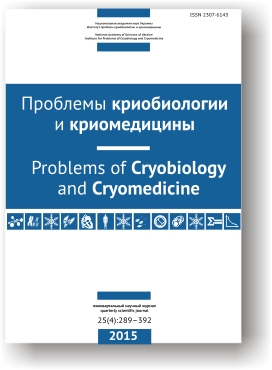ÐŸÑ€ÐµÑ†Ð¸Ð¿Ñ–Ñ‚Ð°Ñ†Ñ–Ñ Ð±Ñ–Ð»ÐºÑ–Ð² із холодоадаптованих личинок Tenebrio molitor у приÑутноÑÑ‚Ñ– ПЕГ-6000
DOI:
https://doi.org/10.15407/cryo25.04.350Ключові слова:
холодова аклімаціÑ, білки, поліетиленгліколь, преципітаціÑ, електрофорезАнотація
У порівнÑльному аÑпекті доÑліджено Ñпектри преципітованих ПЕГ-6000 білків неаклімованих та аклімованих личинок Tenebrio molitor. Показано, що ÑкіÑний Ñклад кріопреципітованих білків аклімованих Ñ– неаклімованих личинок T. molitor має відмінноÑÑ‚Ñ–. Зокрема, у білкових Ñпектрах фільтратів із аклімованих личинок з'ÑвлÑлиÑÑ Ð±Ñ–Ð»ÐºÐ¸ з м. м. 11 кДа, Ñкі відÑутні у неаклімованих комах. Під Ñ‡Ð°Ñ Ð¿Ñ€ÐµÑ†Ð¸Ð¿Ñ–Ñ‚Ð°Ñ†Ñ–Ñ— білків із гомогенатів холодоаклімованих Ñ– неаклімованих личинок ÑпоÑтерігалаÑÑ Ð·Ð½Ð°Ñ‡ÑƒÑ‰Ð° Ñ€Ñ–Ð·Ð½Ð¸Ñ†Ñ Ð² кількоÑÑ‚Ñ– преципітату при концентраціÑÑ… поліетиленгліколю 12% Ñ– більше. Білки із фільтратів аклімованих личинок у приÑутноÑÑ‚Ñ– 6%-го розчину ПЕГ-6000 оÑаджувалиÑÑ Ð½Ð° 44 Ñ– 56% більше, ніж білків із неаклімованих оÑобин при 22 Ñ– 4°С відповідно. Ð—Ð±Ñ–Ð»ÑŒÑˆÐµÐ½Ð½Ñ ÐºÐ¾Ð½Ñ†ÐµÐ½Ñ‚Ñ€Ð°Ñ†Ñ–Ñ— ПЕГ-6000 з 4 до 6% призводило до поÑви в преципітатах із аклімованих личинок білків у діапазоні м. м. 30–42,5 кДа, Ñкі відÑутні у неаклімованих комах.
Посилання
Aghajari N., Feller G., Gerday C. et al. Structures of the psychrophilic Alteromonas haloplanctis a-amylase give insights into cold adaptation at a molecular level. Structure 1998; 6 (12): 1503–1516. CrossRef
Alvarez M., Zeelen J.P., Mainfroid V. et al. Triose-phosphate isomerase (TIM) of the psychrophilic bacterium Vibrio marinus. Kinetic and structural properties. J Biol Chem 1998; 273 (4): 2199–2206. CrossRef PubMed
Arnоrsdоttir J., Smaradоttir R.B., Magnusson O. et al. Characterization of a cloned subtilisin-like serine proteinase from a psychrotrophic Vibrio species. Eur J Biochem 2002; 269 (22): 5536–5546. CrossRef
Ciardiello M.A., Camardella L., Carratore V. et al. L-glutamate dehydrogenase from the antarctic fish Chaenocephalus aceratus. Primary structure, function and thermodynamic characterisation: relationship with cold adaptation. Biochim Biophys Acta 2000; 1543 (1): 11–23. CrossRef
Bhat R., Timasheff S.N. Steric exclusion is the principal source of the preferential hydration of proteins in the presence of polyethylene glycols. Protein Science 1992; 1: 1133–1143. CrossRef PubMed
Fields P.A., Houseman D.E. Decreases in аctivation еnergy and substrate affinity in cold-adapted A4-lactate dehydrogenase: evidence from the Antarctic notothenioid fish Chaeno-cephalus aceratus. Mol Biol Evol 2004; 21 (12): 2246–2255. CrossRef PubMed
Gulevsky A.K., Ryazantsev V.V., Grischenkova Ye.A., Relina L.I. Changes in protein composition of mealworms (Tenebrio molitor) during cold acclimation. Problems of Cryobiology 1995; (4): 29–32.
Korolevskaya L.B., Shmagel K.V. Spectroturbidimetric deter-mination of serum aggregates formed in polyethylene glycol. Immunologiya 2010; 31 (2): 108–111.
Liou Y.C., Daley M.E., Graham L.A. et al. Folding and structural characterization of highly disulfide-bonded beetle antifreeze protein produced in bacteria. Protein Expr Purif 2000; 19 (1): 148–157. CrossRef PubMed
Marshall C.B., Daley M.E., Graham L.A. et al. Identification of the ice-binding face of antifreeze protein from Tenebrio molitor. FEBS Lett 2002; 529 (2–3): 261–267. CrossRef
Osterman L.A. Methods of investigating proteins and nucleic acids: Electrophoresis and ultracentrifugation. Moscow, Nauka; 1981.
Paithankar K. R., Prasad K. S. Precipitation of DNA by polyethylene glycol and ethanol. Nucleic Acids Res 1991; 19 (6): 1346.
Peng J., Xia Z., Chen L. et al. Rapid and efficient isolation of high-quality small RNAs from recalcitrant plant species rich in polyphenols and polysaccharides. PLoS ONE 2014; 9 (5): e95687. CrossRef PubMed
Rizzello Ð., Romano A., Kottrab G. et al. Protein cold adaptation strategy via a unique seven-amino acid domain in the icefish (Chionodraco hamatus) PEPT1 transporter. PNAS 2013; 110 (17): 7068–7073. CrossRef PubMed
Qin W., Walker V.K. Tenebrio molitor antifreeze protein gene identification and regulation. Gene 2006; 367: 142–149. CrossRef PubMed
Scopes R. Methods of protein purification. Moscow, Mir; 1985.
Shulgin I.L., Ruckenstein E. Preferential hydration and solubility of proteins in aqueous solutions of polyethylene glycol. Biophysical Chemistry 2006; 120: 188–198. CrossRef PubMed
Yakhontov V.V. Pests of agricultural plants and products of Central Asia and actions against them. Tashkent, Gosizdat UzSSR; 1953.
Zhangyong He., Ying Zhu., Hongchen Gu. A new method for the determination of critical polyethylene glycol concentration for selective precipitation of DNA fragments. Applied Micro-biology and Biotechnology 2013; 97 (20): 9175–9183. CrossRef PubMed
Downloads
Опубліковано
Як цитувати
Номер
Розділ
Ліцензія
Авторське право (c) 2020 Aleksandr K. Gulevsky, Elena O. Grischenkova, Liana I. Relina, Diana V. Tretyak

Ця робота ліцензується відповідно до Creative Commons Attribution 4.0 International License.
Автори, які публікуються у цьому журналі, погоджуються з наступними умовами:
- Автори залишають за собою право на авторство своєї роботи та передають журналу право першої публікації цієї роботи на умовах ліцензії Creative Commons Attribution License, котра дозволяє іншим особам вільно розповсюджувати опубліковану роботу з обов'язковим посиланням на авторів оригінальної роботи та першу публікацію роботи у цьому журналі.
- Автори мають право укладати самостійні додаткові угоди щодо неексклюзивного розповсюдження роботи у тому вигляді, в якому вона була опублікована цим журналом (наприклад, розміщувати роботу в електронному сховищі установи або публікувати у складі монографії), за умови збереження посилання на першу публікацію роботи у цьому журналі.
- Політика журналу дозволяє і заохочує розміщення авторами в мережі Інтернет (наприклад, у сховищах установ або на особистих веб-сайтах) рукопису роботи, як до подання цього рукопису до редакції, так і під час його редакційного опрацювання, оскільки це сприяє виникненню продуктивної наукової дискусії та позитивно позначається на оперативності та динаміці цитування опублікованої роботи (див. The Effect of Open Access).




